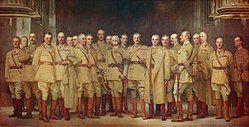File:1922 John Singer Sargent - General Officers of World War I - Detail.jpg

Original file (2,400 × 530 pixels, file size: 997 KB, MIME type: image/jpeg)
Captions
Captions
Summary[edit]
| John Singer Sargent: General Officers of World War I
|
||||||||||||||||||||||
|---|---|---|---|---|---|---|---|---|---|---|---|---|---|---|---|---|---|---|---|---|---|---|
| Artist |
artist QS:P170,Q155626 |
|||||||||||||||||||||
| Title |
General Officers of World War I |
|||||||||||||||||||||
| Object type |
painting |
|||||||||||||||||||||
| Genre |
group portrait |
|||||||||||||||||||||
| Depicted people |
|
|||||||||||||||||||||
| Date |
1922 date QS:P571,+1922-00-00T00:00:00Z/9 |
|||||||||||||||||||||
| Medium |
oil on canvas medium QS:P186,Q296955;P186,Q12321255,P518,Q861259 |
|||||||||||||||||||||
| Dimensions | 299.7 × 528.3 cm (9.8 × 17.3 ft) | |||||||||||||||||||||
| Collection | National Portrait Gallery | |||||||||||||||||||||
| Current location |
London |
|||||||||||||||||||||
| Accession number |
NPG 1954 |
|||||||||||||||||||||
| Place of creation |
United States of America |
|||||||||||||||||||||
| Notes |
English: The painting depicts 22 of the approximately 1,500 brigadier-generals, major-generals, lieutenant-generals, generals, and field marshals who served in the British and Imperial armies in the First World War. All but two of the subjects reached the rank of at least lieutenant-general, and most were commanders of armies or army corps. The only two divisional commanders are Major-General Lukin and Major-General Russell.
From left to right, they are:
|
|||||||||||||||||||||
| References | ||||||||||||||||||||||
| Source/Photographer |
National Portrait Gallery: NPG 1954
|
|||||||||||||||||||||
| Permission (Reusing this file) |
|
|||||||||||||||||||||
| Other versions |
|
|||||||||||||||||||||
File history
Click on a date/time to view the file as it appeared at that time.
| Date/Time | Thumbnail | Dimensions | User | Comment | |
|---|---|---|---|---|---|
| current | 08:23, 24 February 2018 | 2,400 × 530 (997 KB) | Waterborough (talk | contribs) | better version | |
| 07:13, 24 February 2018 | 2,400 × 530 (991 KB) | Waterborough (talk | contribs) | == {{int:filedesc}} == {{Artwork |wikidata = Q16992699 |Title = ''General Officers of World War I'' |Artist = {{creator:John Singer Sargent}} |Year = 1922 |Technique = {{Technique|oil|canvas}} |Dimensions = {{size|cm|299.7|528.3}} |Gallery = National Portrait Gallery |Location = London |Notes = {{en|The painting depicts 22 of the approximately 1,500 brigadier-generals, major-generals, lieutenant-generals, generals, and field marshals who served in the British and Imperial armies in the First World War. All but two of the subjects reached the rank of at least lieutenant-general, and most were commanders of armies or army corps. The only two divisional commanders are Major-General Lukin and Major-General Russell. From left to right, they are: #Field Marshal William Birdwood, 1st Baron Birdwood (commander of the Australian and New Zealand Army Corps from 1914 to 1916, and of the British Fifth Army in 1918) #Field Mar... |
You cannot overwrite this file.
File usage on Commons
The following 3 pages use this file:
File usage on other wikis
The following other wikis use this file:
- Usage on de.wikipedia.org
- Usage on ru.wikipedia.org
Structured data
Items portrayed in this file
depicts
image/jpeg
f46efd260aa925b3140e0cb970148ccff98177ef
1,020,925 byte
530 pixel
2,400 pixel
- General Officers of World War I
- British Army personnel of World War I
- Generals of the United Kingdom
- 20th-century group portraits
- Group portraits with 22 people
- General Officers of World War I (NPG 1954) by John Singer Sargent
- William Birdwood, 1st Baron Birdwood
- Jan Smuts
- Louis Botha
- Julian Byng, 1st Viscount Byng of Vimy
- Henry Rawlinson, 1st Baron Rawlinson
- Henry Lukin
- John Monash
- Henry Horne, 1st Baron Horne
- George Milne, 1st Baron Milne
- Henry Hughes Wilson
- Andrew Hamilton Russell
- Herbert Plumer, 1st Viscount Plumer
- John Cowans
- Douglas Haig, 1st Earl Haig
- John French, 1st Earl of Ypres
- Sir William Robertson, 1st Baronet
- Frederick Stanley Maude
- Edmund Allenby, 1st Viscount Allenby
- William Raine Marshall
- Arthur Currie
- Rudolph Lambart, 10th Earl of Cavan
- Charles Macpherson Dobell



